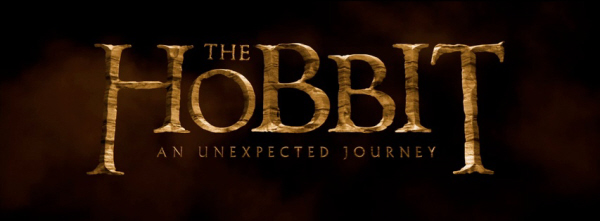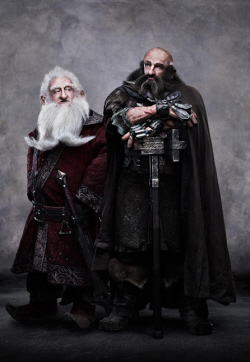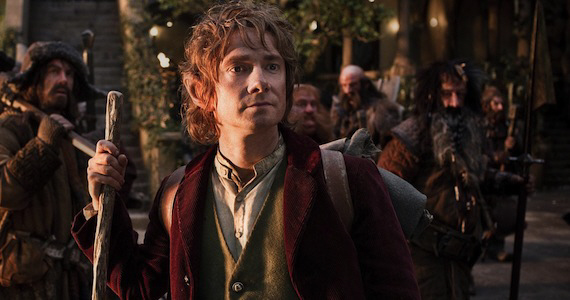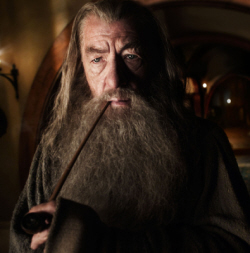
Let’s relay this in simplest terms, Peter Jackson’s The Hobbit: An Unexpected Journey is the Diet Coke of Rings movies. The taste is altogether similar, yet with every sip you’re reminded the difference. A lighter, more disjointed, flatter affair, this latest visit to Middle Earth manages to fulfill just enough even if it doesn’t always come together like it should.
 I’m not ready to call Jackson’s frame rate experiment a failure. But, as it pertains to The Hobbit, the 48 frames per second format is richly beautiful in moments, completely jarring in others and always unnecessary. When Jackson’s shooting the rolling hills and vast expanses of New Zealand you’re treated to a rich, almost naked-feeling, visual experience unlike any you’ve ever seen. But a pristine, soap opera-esque sheen and peculiarity underlying the chaotic action sequences do Jackson’s effort a vast disservice. From the first time Ian Holm reaches for his pen, you’ll recognize something as just… off. Chris Nolan’s quick to remind audiences his aversion to 3D comes from a place of not wanting to remind his audience they’re watching a film – a respectable stance even if I find myself agreeing with it less in the past year. The issue with High Frame Rate in its early form, and why it works against a fantasy-driven narrative like Hobbit, is how often it makes its presence known – always reminding you you’re watching a movie just as you begin to drift once again into Tolkien’s world. Waiting for your eyes to adjust does little good, as its omnipresence remains throughout.
I’m not ready to call Jackson’s frame rate experiment a failure. But, as it pertains to The Hobbit, the 48 frames per second format is richly beautiful in moments, completely jarring in others and always unnecessary. When Jackson’s shooting the rolling hills and vast expanses of New Zealand you’re treated to a rich, almost naked-feeling, visual experience unlike any you’ve ever seen. But a pristine, soap opera-esque sheen and peculiarity underlying the chaotic action sequences do Jackson’s effort a vast disservice. From the first time Ian Holm reaches for his pen, you’ll recognize something as just… off. Chris Nolan’s quick to remind audiences his aversion to 3D comes from a place of not wanting to remind his audience they’re watching a film – a respectable stance even if I find myself agreeing with it less in the past year. The issue with High Frame Rate in its early form, and why it works against a fantasy-driven narrative like Hobbit, is how often it makes its presence known – always reminding you you’re watching a movie just as you begin to drift once again into Tolkien’s world. Waiting for your eyes to adjust does little good, as its omnipresence remains throughout.
So high frame rate becomes something of an anomaly as it pertains to this film. Colorfully rich with clunky movements, stunningly beautiful yet exceedingly jarring, the frame rate brings you closer to the camera’s subjects while maintaining its frustrating persistence in pulling you out of the story. It demands to be seen yet it contradicts any and all attempts to maintain a consistent visual experience to the original films. It belongs in a James Cameron underwater doc. As far way from The Hobbit as possible.
If I can’t assuage your concerns regarding 48fps, perhaps I can do so with the story being told. The Hobbit: An Unexpected Journey is an entertaining time if you’re willing to forgive its inconsistencies. The film’s right episodic in nature, springing from one action piece to the next and never introducing a new peril before wrapping up the previous. It helps to think of Hobbit more as a series of skits, almost Jackass: Middle Earth Edition, than as connective narrative. In reality, the film’s failings owe a great deal to the shortcomings of Tolkien’s book. As many of the same gripes are voiced in the direction of the source material.
Gandalf folds the young Bilbo Baggins into his merry band of dwarves, attempting to take back the treasures of the kingdom from the dragon Smaug, setting up the Hobbit’s journey of self-doubt giving way to heroism. And in that aspect, this relatively simple journey from point A to point B, Hobbit should work better than it does. Martin Freeman’s performance as Bilbo is effective if marginalized, as Jackson spends most of the film with the dwarfs and their leader, Thorin Oakenshield (Richard Armitage). It’s not a terrible misstep per se, as Armitage gives a winning performance surrounded by a capable cast of likeminded dwarfs (Ken Stott’s elder statesman Balin being the notable standout).
But it lessens Bilbo’s arc considerably. And the relationship between Bilbo and Gandalf never feels as complex or fleshed out as the wizard’s interactions with Frodo in Fellowship. Jackson worked effectively to establish history in that film, but there’s a lessor Gandalf here and McKellan looks tired for stretches. Now that we’re viewing the storied history, the gray wizard’s trust of hobbits isn’t much deeper than “They’re tiny and therefore trustworthy.” Even the reason Bilbo’s chosen, to be a burglar and give the dwarves a stealthy edge on their quest, doesn’t pay off as you’d hope. Whatever Gandalf sees in Bilbo in the early stretch, the audience cannot. His reluctance to join up is downright logical, hampering the resonance of an eventual change of heart.

A common problem with prequels lies in the notion they’re mostly just setup to achieve a familiar status quo. The first half of Journey is too much setup, too much fat, and our time in Bagend, as well as Bilbo’s reluctant recruitment, could’ve stood to be shortened considerably. We’re familiar with this world and a prolonged reintroduction does more damage than good.
But Jackson’s directing hand gets stronger. By the time we reach Rivendell, the film finally feels in step. Once the focus is there, once the eyes are on the prize, we can begin to care about the journey. Still there’s a vast divide between the second and first halves of the film. As the pacing gets sorted out, so to do many of the Hobbit‘s nagging issues. Bilbo finally becomes a player, Oakenshield gets to be a badass, and McKellan gets to shine as Gandalf the Grey. And Gollum’s there too.
 I won’t spoil the scene. But Serkis and Freeman play a grand dynamic in the film – sadly Freeman’s only real opportunity to shine as Bilbo. The performers lift Hobbit out of the ruts it’s mired in. It’s one of my favorite moments in the film, or in any Lord of the Rings film for that matter. This, the veritable money shot, is the Middle Earth you’re keen to revist.
I won’t spoil the scene. But Serkis and Freeman play a grand dynamic in the film – sadly Freeman’s only real opportunity to shine as Bilbo. The performers lift Hobbit out of the ruts it’s mired in. It’s one of my favorite moments in the film, or in any Lord of the Rings film for that matter. This, the veritable money shot, is the Middle Earth you’re keen to revist.
The final battle and ensuing conclusion are smaller scale, consistent with the tonal shift and stakes. If I have one final complaint, and it’s evidenced in this scene as well, Jackson’s become less reliant on the practical craft here. The orcs and goblins are 90% CG this time out, so while there’s nothing particularly wrong with the effects, it’s another inconsistency with the incredible make-up effects of the original trilogy.
Don’t worry about The Hobbit: An Unexpected Journey. Give it time to wash over you, play itself out. It takes missteps getting where it’s going, but Jackson pulls it off without terrible incident. It won’t dampen your rosy memories of the originals but I’d venture a guess it won’t richly enhance them either. Neither what you’d hoped for nor what you feared, Jackson’s Journey is a mildly amusing return to the world of J.R.R. Tolkien.
Even if it doesn’t offer the same great taste.
Rating: 




Out of a Possible 5 Stars